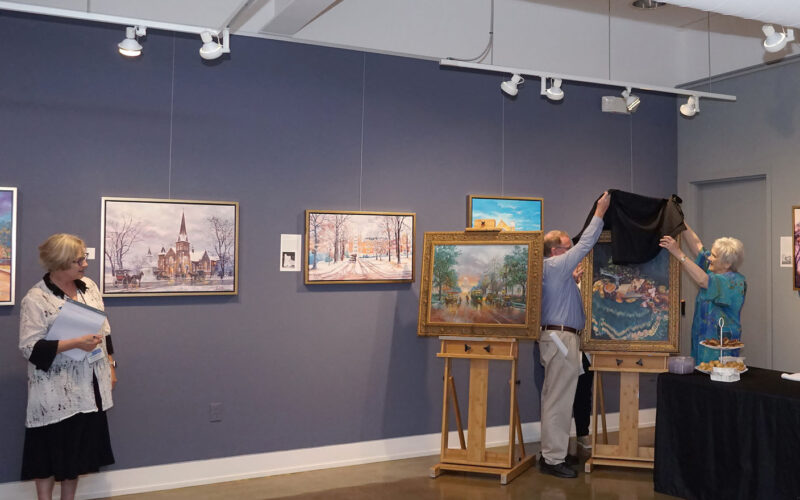BECCA MARTIN-BROWN
bmartin@nwaonline.com
As a aficionado of the Fort Smith Regional Art Museum, you might think you’ve seen all of John Bell Jr.’s artwork there is to see.
Gallery Manager Casey Seamans would like to assure you that you are wrong — and you will be delighted to be so.
“While our collection of original John Bell Jr. artwork continues to grow with the help of the John Bell Jr. Legacy Society, the fact is [that] most of Bell’s iconic images, such as the churches and historical buildings and landmarks, reside in private collections,” says Seamans, who has been with FSRAM since 2014. “The idea was to bring these images to life as an exhibition of high-quality canvas prints, and after showing at RAM, begin traveling the exhibit across the state and country, educating people about the life and art of John Bell Jr.”
“John Bell Jr.: A Painted Legacy,” open through Oct. 15, features 30 of what Seamans calls “the most beloved” images by Bell, arguably Fort Smith’s most famous artist. Fans recognize his romantic images of iconic structures across the River Valley, in Eureka Springs and around Arkansas, but thanks to state-of-the-art reproduction technology, more of them can now be seen at FSRAM.
The rewards for the museum, the art world and the legacy of John Bell Jr. are multi-fold.
“One of the most exciting things is simply seeing all of these iconic images together,” Seamans says. “The second thing is the amazing quality of the images. High-resolution pictures were taken of each original piece of artwork, and carefully color-corrected using the FADGI (Federal Agencies Digital Guidelines Initiative) standard of cultural heritage materials for archival objects.
“Then, using state-of-the-art commercial-grade, UV resistant inks, CanvasHQ has been able to accurately re-create Bell’s images as beautiful canvas prints with all of the rich colors and soft lighting effects for which Bell’s paintings are renowned,” she explains. “They are truly breathtaking.”
And, she adds, they are resilient.
“Original artwork must be maintained at a certain temperature and humidity for conservation purposes,” Seamans says. “Unfortunately, this means the venues where artwork can travel and be displayed are very limited, generally only other art institutions and museums. The fact that ‘John Bell Jr. A Painted Legacy’ are not the original oils on canvas means that all types of institutions will be able to host the exhibition.”
And that’s the plan. As the first traveling exhibit created by FSRAM, it will be on the road between 2024 and 2026.
Seamans says it will take about 1,300 to 1,700 linear feet of space to show the exhibition, and there will, of course, be a fee, plus the cost of shipping and insurance. However, exhibitors get not just the artwork but a history lesson.
“In its entirety, the traveling ‘John Bell Jr. A Painted Legacy’ exhibit will include 30-47 high resolution canvas prints — the size of the venue will determine how many images will exhibit — text panels that touch on inaccessibility and inequality for people with disabilities, and a panel about Bell’s contributions and involvement with the United Cerebral Palsy Association,” Seamans says. “There will also be panels discussing his artistic designs for Brook’s Fabrics, Willard Mirror Company and Master Creations. Images of John Bell Jr. with his wife, Maxine Bell, will be included, as well as a DVD of interviews with some of John’s family members.”
Born in 1937, Bell was bound to a wheelchair by cerebral palsy and worked not only as an artist but as an advocate for people with disabilities.
“While I knew both John and his wife were wheelchair-bound, I didn’t fully understand until recently the prejudice he faced trying to find work due to his being physically challenged or how hard he worked to champion accessibility to public buildings, parks and restaurants for others that use wheelchairs,” Lou Meluso, the museum’s former director, said in a 2021 interview about the donation of Bell’s works to FSRAM. “He lobbied City Hall to have electronic button access to open doors. He helped design picnic tables in state parks and was instrumental in developing wheelchair access to the playground in Creekmore Park. He even designed a wheelchair accessible automobile.”
The gift to the museum included 50 original artworks, including original oil and watercolor paintings, pen and ink and pencil drawings, linocut and scratchboard, and, Meluso added,“the museum now holds a treasure trove of offset lithographs of his most iconic images and items from his studio, including paintbrushes, scale models, his iconic hat, camera, photos and correspondence for various acquisitions and artist requests.”
“Receiving the family gift of John Bell Jr.’s art and career artifacts has been the most significant happening in RAM’s history,” Julie Moncrief, director of development for FSRAM, said in 2022. “The obligations we now have include the task of the conservation and preservation of more than 50 original works of art, Bell’s studio items, personal items, photographs and correspondence — all in all, more than 100 items.
“On top of that is the sharing of this gift, which is also our opportunity: Museums function to create cohesiveness in a community, and now RAM will share the story of our own native son whose life is an inspiration and whose art helps us know and appreciate our past.”
“Some people in my position at a museum work their whole lives and never get to be a part of a project this amazing and special, but I do,” Seamans adds. “It really is an honor.”
FAQ
‘John Bell Jr.: A Painted Legacy’
WHEN — Through Oct. 15; gallery hours are 11 a.m.-6 p.m. Tuesday-Saturday & 1-5 p.m. Sunday
WHERE — Fort Smith Regional Art Museum, 1601 Rogers Ave. in Fort Smith
COST — Free
INFO — fsram.org; 784-2787



